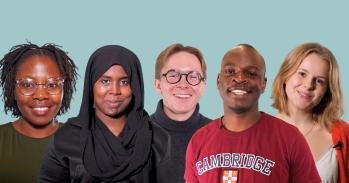
To maximise the efficiency of solar cells of the future, physicists are taking a leaf out of nature’s book.
To maximise the efficiency of solar cells of the future, physicists are taking a leaf out of nature’s book.
The materials science of the last century was focused on bulk materials, but now it’s all about introducing structure on a smaller scale
Nicholas Hine
Through billions of years of evolution, life on Earth has found intricate solutions to many of the problems scientists are currently grappling with. Physicists at the University of Cambridge’s Cavendish Laboratory are trying to unravel nature’s secrets to develop new energy-generating technologies for a more sustainable future.
Focusing on the ancient green sulphur bacteria, research fellows Dr Alex Chin and Dr Nicholas Hine are investigating the early stages of photosynthesis – the process in which plants and some bacteria capture the sun’s light energy and convert it into chemical energy, or food.
“The light-harvesting states of photosynthesis are highly efficient in many species, and happen extremely fast – within a nanosecond, if not picoseconds,” said Chin. “We’re very interested in that efficiency and how it’s managed. Biology has evolved phenomenally subtle systems to funnel light energy around and channel it to the right places. It has also become incredibly good at building tiny devices that work with high efficiency, and at replicating them millions of times.”
Green sulphur bacteria are found in places with very little light, including at the bottom of the oceans, and have existed for billions of years by harvesting light extremely efficiently in order to photosynthesise. Chin and Hine are trying to discover the intimate detail of the bacteria’s clever solutions to capturing and converting light energy. “The idea is to tease out what the trick is,” said Chin. “We’d like to learn, understand and in some sense copy this in artificial systems.”
“Light harvesting is one area where evolution has produced systems that take advantage of quantum mechanics,” said Hine. “I simulate the materials involved from first principles. If you know where the atoms are, you can describe the system using only what we know about quantum mechanics.”
“We need to know about the molecular arrangements to identify the properties that lead to this high efficiency,” added Chin. “I use Nick’s simulations as input into a model I can set in motion, to see how energy will flow.” By working together, the pair is developing an understanding of this photosynthetic system, from where each individual atom is positioned to how the whole system functions.
The idea is to generate broader design principles for new nanomaterials that can be used to build better types of photovoltaic device, or solar cell. “Once we understand the system, we can then move into synthetic chemistry, solid state physics and materials science, and see if we can mimic it,” said Chin. “This may be in a simpler way, but hopefully a scalable one that is useful for industry.”
“Ultimately we want to make devices that harvest the maximum amount of the available sunlight,” said Hine. “Existing materials, like the solar cells on people’s roofs, only absorb about 20% of energy from the sun to turn into electricity. The trick is to make sure the material is tailored to absorb all the energy it possibly can. This way, solar panels become an increasingly attractive source of sustainable energy in the future.”
“Most current ways of building photovoltaic materials have been arrived at to a great extent by chance,” said Hine. “We’re taking a step back and asking whether we can work out from simulations how well materials are going to perform. The materials science of the last century was focused on bulk materials, but now it’s all about introducing structure on a smaller scale.”
A pioneering programme
As Winton Advanced Research Fellows, Chin and Hine are among the first scientists to be offered postdoctoral positions within the prestigious Winton Programme for the Physics of Sustainability. The programme was created in 2011 with a pledge of £20 million from David Harding, the founder, chairman and head of research of Winton Capital Management. His goal is to make new technologies available that address the big sustainability challenges facing society, by promoting fundamental science under the broad remit of sustainability.
“The Winton Programme is a brilliant opportunity to get established as a scientist,” said Hine. “The Fellowships give you a chance to launch your own independent research, and also collaborate with a huge network of people in Cambridge doing sustainability research in one way or another.”
“The Physics of Sustainability defines a grand challenge,” said Professor Sir Richard Friend, Director of the Winton Programme. “Sustainability is about finding better solutions in areas where we use huge amounts of material, like lighting, batteries and water-purification systems. These are areas where current solutions are inefficient and we should be able to do much better.”
In June 2013, Cambridge was awarded £21 million in government funding from the Higher Education Funding Council for England (HEFCE) towards the construction of The Maxwell Centre, where blue skies physics research will be translated into industrial applications. This £63 million centrepiece of the Cavendish’s redevelopment will house the Winton Programme in addition to research scientists from other Cambridge research groups and industry.
“The Maxwell Centre will be a one-stop-shop for physical sciences on the West Cambridge site, helping to grow our industry-facing activities,” said Friend. “We need to be opportunistic and be confident that where we have great ideas and enthusiastic scientists, industry will back us. The Centre is a great opportunity to set up labs oriented towards Winton activities.”
“David Harding talks about keeping the skies blue,” said Friend. “His funding means we can be bold and start activities we couldn’t have done otherwise, because they’re too early-stage, or don’t fit the areas funded through traditional routes. We are giving very bright younger scientists a lot of freedom to build up new research programmes, and that way I hope we will cause things to happen that wouldn’t have happened otherwise.”
The programme also provides PhD studentships, support for new academic staff, investment in research infrastructure of the highest level, pump-priming for novel research projects, support for collaborations within the University and outside, and sponsorship for meetings and outreach activities.
Friend is keen to point out that, despite centuries of breakthroughs in science that have brought us to the present day, the opportunities ahead are just as great. “There is everything still to discover, and most of it will turn out to be, for unexpected reasons, remarkably useful.”
This work is licensed under a Creative Commons Licence. If you use this content on your site please link back to this page.





